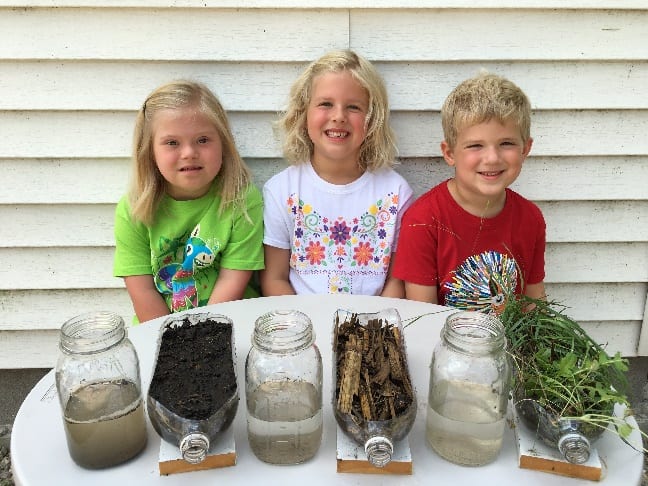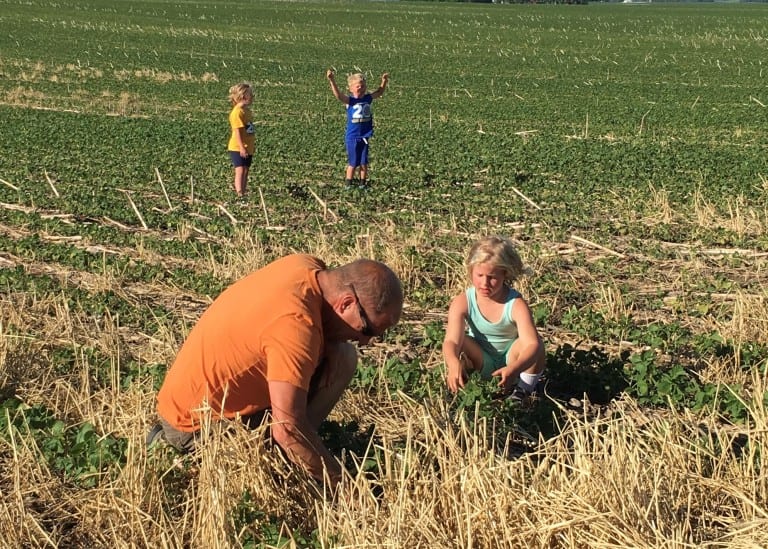
They say a picture’s worth a thousand words, so I think the photo you see above explains why I plant cover crops better than I can articulate in words.
At first glance, this may seem nothing more than a school science experiment. But take a closer look and you’ll see varying degrees of soil erosion in this field:
- With bare soil, as we might have if we harvested and also tilled the land – The photo on the left demonstrates a post-harvest field, without cover crops. You can see the water has washed away some of the soil.
- With field debris – The center photo shows a field that we harvested but did not till the stalks remaining from the previous crop.
- With a cover crop – The photo on the right, with the cover crop (in this case, a blend of clover, rye and radish), shows how water runs off clearly, leaving the land intact.
My husband, Bryan, and I farm about 2,500 acres of corn and soybeans on his family’s farm in southwest Minnesota. As you might imagine, right now we’re gearing up to harvest these crops this fall.
What might surprise you is that we’re also planning to plant hundreds of acres of turnips, rye, radishes and other blends that we will never harvest. No, we’re not crazy. We plant these as cover crops, or crops that stay in our soil over the winter to prevent erosion and improve soil and water quality.
With so many lakes in Minnesota, water quality is a hot issue these days – both here and in most other areas, too. We’ve also experienced some rough weather over the last five years. Pounding rain and high winds can erode the land, but cover crops help hold the soil in place protecting it from water and wind.
We also enjoy the sustainable benefits of organic matter in our soil, which is helpful to next year’s corn and soybean crops. When cover crops decompose, they release rich, nutrient-filled organic matter in the soil. This is beneficial to the crop we’ll plant in this soil next season. So, on our farming operation, cover crops help us improve the overall quality of our soil and water.

A leap of faith
Cover crops are not new. In fact, they’ve been around for generations.
In our case, our commitment to water conservation made us give them a second look. It wasn’t an immediate decision. We tend to find the practices that work best for our operation and stick to them. Not to mention, adopting cover crops requires farmers to take giant leaps of faith by overhauling their management systems or making additional financial commitments in seed and equipment.
New crops also take trial and error, and we continue to experiment to learn the ideal time to plant our cover crops. We’re lucky to have a knowledgeable seed dealer who helped us determine the right mix of seed (rye is effective for erosion control, for instance, while clover adds nitrogen to the soil) and the best timing for it.
Cover crops are planted before our corn and soybeans are harvested. There are various ways to plant seed amidst 12-foot-tall corn stalks, but none of them are simple. Many farmers apply cover crop seed by plane (similar to a crop duster). We prefer to use a high-clearance seeder – with lots of trial and error, and lots of precision, required.

The intersection of technology and sustainability
Knowledge is power, and we apply the same research to cover crops as we do to a new technology. Before adopting either, we learn what we can and try to talk to farmers with similar growing conditions who have experience with it. What’s right for one farm is not right for all, so we tailor a specific technology or practice to meet our needs. We pride ourselves on being conservation-minded while planting the latest technology.
Like technology, cover crops are just one component of the overall system we use to successfully and sustainably produce a crop while protecting our land and water for future generations.
